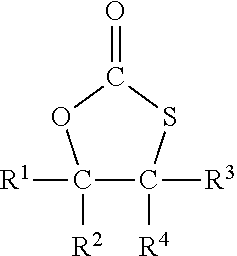Method for the preparation of compounds with cyclic monothiocarbonate groups
a technology of cyclic monothiocarbonate and compound, applied in the field of compound preparation with cyclic monothiocarbonate group, can solve the problems of limited availability of carbonyl sulfide, complicated processes, and requiring the use of harmful materials
- Summary
- Abstract
- Description
- Claims
- Application Information
AI Technical Summary
Benefits of technology
Problems solved by technology
Method used
Image
Examples
examples
[0092]GC analysis: Agilent Technologies 7890 A Network GC System
Column: DB1 (Agilent) 30 m, Ø 0.25 mm, film thickness 1 μm;
Carrier gas He; flow 1.0 mL / min; split ratio: 50:1
T-program: 50° C.-300° C., with ramp rate of 10° C. / min; 30 min isotherm
Temperature (injection system) 250° C.
synthesis example
[0093]5-(Chloromethyl)-1,3-oxathiolane-2-one was used as compound of formula (III). 5-(Chloromethyl)-1,3-oxathiolane-2-one was prepared according to WO 2019 / 034469 A1 as follows:
[0094]Into a 2 L stirred tank glass reactor equipped with two condensers (−30° C. and −78° C. (dry ice)) phosgene dip pipe and internal thermometer 594 g (6.41 mol, 1.00 eq.) of epichlorohydrin were introduced under an atmosphere of nitrogen. After the addition of the starting material the cooling of the tank reactor was turned on and was adjusted to 15° C. After the reactor reached this temperature, 17.8 g (0.0640 mol, 1.00 mol %) of tetrabutylammonium chloride (TBACl) were added. After solvation of the TBACl gaseous phosgene (overall 821 g, 8.3 mol, 1.29 eq.) was added to the reactor via the dip pipe. The temperature of the reaction mixture was continuously monitored and was kept below 25° C. by carefully adjusting the rate of the phosgene addition. Overall the phosgene addition took approximately 9 hours....
example 1
[0096]
[0097]Sodium thiophenolate (0.61 g, 5 mmol) was dissolved in dimethylformamide (DMF) (6 g) and 5-(chloromethyl)-1,3-oxathiolane-2-one (0.76 g, 5 mmol) was added. The solution was heated to 120° C. and stirred for 2 hours.
[0098]Based on GC analysis 75% conversion of the 5-(chloromethyl)-1,3-oxathiolane-2-one was achieved, and 5-(phenylsulfanylmethyl)-1,3-oxathiolane-2-one (C10H10S2O2) was afforded in 67% yield.
GC-MS analysis: GC (Agilent 7890 A) coupled with MS (Agilent 5975 C) for El and Cl ionisation
GC Column: DB1701, 30 m, Ø 0.25 mm, film thickness 1 μm;
Carrier gas He; flow 1.2 mL / min; split ratio: 30:1
T-program: 50° C.-280° C., with ramp rate of 20° C. / min; 30 min isotherm Temperature (injection system) 250° C.
MS / El, mass range 25-785 amu; ionization energy 70 eV
MS / Cl, mass range 55-815 amu
[0099]The molecular weight of 226 was determined by El and Cl ionization. The structure of 5-(phenylsulfanylmethyl)-1,3-oxathiolane-2-one was confirmed by 1H-NMR (CD2Cl2).
PUM
 Login to View More
Login to View More Abstract
Description
Claims
Application Information
 Login to View More
Login to View More - R&D
- Intellectual Property
- Life Sciences
- Materials
- Tech Scout
- Unparalleled Data Quality
- Higher Quality Content
- 60% Fewer Hallucinations
Browse by: Latest US Patents, China's latest patents, Technical Efficacy Thesaurus, Application Domain, Technology Topic, Popular Technical Reports.
© 2025 PatSnap. All rights reserved.Legal|Privacy policy|Modern Slavery Act Transparency Statement|Sitemap|About US| Contact US: help@patsnap.com



